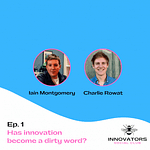SIDEBAR is a podcast born out of the Innovators Social Club, hosted by Iain Montgomery and Charlie Rowat. It’s the conversation after the main event, exploring tangents that could turn into something bigger. The sort of topics that spark up in the room but don’t always make it into the official dialogue.
Rooted in the discussions that emerge from the innovation community and events we host as well as attend, SIDEBAR is an informal, no bullshit exploration of the themes shaping strategy, innovation and business, that perhaps aren’t getting enough airtime. Drawing on our own experiences, guest insights and the occasional contrarian take, we use conversation as a way to test ideas, challenge assumptions and see where things go.
No rehearsed thought leadership. No forced frameworks. Just real discussions about what’s actually working, what’s not and where we should be paying attention next.
A few years ago, Adobe handed out prepaid debit cards to many employees. Not to buy lunch or a new monitor, but to test ideas.
The rough deal was; Got an idea? Great. Here’s a $1,000, a set of prompts, things you should do to test it out and some mentoring slash moral support. Go explore it, and if it starts to look promising, come back and ask for more. That was the Kickbox. It wasn’t so much a framework, and more something akin to building a culture of permission to explore. Giving just enough structure to be useful, not so much that gets in the way.
It’s still one of the best things we’ve seen in corporate innovation.
Because somewhere along the way, organisations stopped trusting people to explore ideas. Innovation in many places became a gesture or a symbol of sprints, labs, idea funnels, methodologies copied from consultancies. Often a process so structured that it squeezed out much of what it was trying to achieve in the first place.
Ask anyone in a company where the last genuinely new idea came from and they’ll usually say something like “someone saw something weird and ran with it.”
So we sat down to talk about what innovation actually looks like these days. And how, even if the word itself is on life support, the work still matters.
Process vs Permission
Most innovation frameworks are designed to make execs feel comfortable.
They’re not bad per se, just overused, oversold and over-reliant on metaphors like ‘stage gates’, ‘funnels’ and ‘design sprints’ that make it sound like you’re being more a serious engineer than an indulgent explorer.
The Kickbox approach works because it lowers the stakes and opens the door. So you don’t need permission slips, lengthy planning phases or try to lock down agendas before anything’s even been tested. Just go figure out whether this thing might be worth doing.
There’s a lovely balance to it that has enough constraint to focus attention (you’ve got a grand and a few weeks, go!), but enough freedom to let real learning happen. Crucially, it comes with trust and belief that people inside the business might actually know something useful and surprising.
Which sadly can feel rare now.
The Trouble With Sprints
Sprints can be good. But lots aren’t.
In theory, they’re a jolt of energy. A temporary burst to get a team unstuck or make a big call. In practice, they’re often a fast-forward button for delivering mediocre outputs under the illusion of progress. You end up with eight sprints across a sixteen-week plan and wonder why everyone’s exhausted and nothing feels new.
Sprint thinking works best when you’ve been stuck, or when you need momentum. It’s like speed work in distance training, you do it occasionally to build capacity, not all the time just to look busy.
Real innovation work is uneven, messy Sometimes slow, sometimes hectic. The point isn’t to be fast all the time, but to figure out what’s worth going faster on.
Product Teams Killed Innovation (and Marketing)
Somewhere in the last decade, ‘product’ quietly swallowed ‘innovation’ and ‘marketing’.
Instead of propositions, we now get features. Instead of questions, we get backlogs. And instead of customer insight driving the work, we get A/B tests … often on quite trivial things.
We’re not anti-product, but product is different to innovation, even if they overlap a fair bit, kind of like the conversation smashed together a lot of analogies. There are great product people out there, but in large corporates, product often becomes a holding pattern. A place where everything new must be filtered through existing architecture, roadmaps and assumptions.
It’s how you end up with a retailer focusing all their energy on the 3% of customers who use the mobile app, and ignoring the 97% who still walk into stores because they’re harder to measure.
It’s how you get BMW going from building the future of mobility (car sharing, electrics, micro-vehicles) to charging people a subscription for heated seats.
From “Why Should We Build It?” to “How Fast Can We Ship It?”
Financialisation is what happens when innovation stops being about long-term value and starts being about quarterly optimisation. You can see it in car companies pivoting from electric R&D to microtransactions, or banks shelving genuinely new services because they won’t pay off this fiscal. The logic becomes “how can we extract more from what already exists—not what’s worth building next”. And once that mindset takes hold, you’re not innovating for customers anymore, you’re innovating for spreadsheets. That shift might not kill the business tomorrow, but it quietly ensures you’ll never lead the next big wave, because you're too busy squeezing the last few drops from the previous one.
It can be how you lose the plot.
A big part of this shift is power. Ten years ago, marketing set the direction and IT delivered the tech. Today, in many companies, product teams, often with engineering roots, hold the reins. They’ve got the budget, the roadmap and the delivery muscle. Marketing, once the voice of the customer and the brand promise, now often gets reduced to launch assets and ad copy. It’s no wonder propositions have vanished, we’ve replaced the ‘why’ with a backlog of ‘how’. And when technical feasibility trumps customer desirability, you end up optimising the machine, not reimagining the experience.
Sometimes the Best Move Is to Just Buy the Damn Thing
Innovation people might not like this, but lots of innovation projects should end with a slide that says:
“Or we could just acquire those guys.”
We discussed this in the contest of a project for a trading platform looking to attract younger, fee-sensitive investors. Having mapped the needs, designed propositions, built journeys, the work was good. A year later, they skipped the roadmap and just bought a challenger for a decent price.
Good call.
Corporate innovation doesn’t like acquisitions because it makes people feel like they didn’t build the thing. But if your goal is to get to the future faster, and someone else is already there, buy it and move on. That can be innovation too.
Innovation Labs Were Mostly Vibes (But Not Useless)
Labs were never the future of innovation. At best, they were a permission slip to behave differently for a little while. A corporate hall pass for breaking rule like launching a prototype without going through procurement, testing something scrappy without legal redlines or saying “what if we did this?” without getting shut down.
But somewhere along the way, the performance swallowed the purpose. The lab became the innovation story, ping pong tables, exposed brick & beam and one case study a year that could be trotted out to prove the business was “future-facing”. Behind the scenes, most labs were isolated, underpowered and quietly resented by the core business for being flashy and different but ultimately untethered.
That doesn’t mean they were worthless. In fact, when they worked, it was usually because someone stole an idea from the lab and made it real elsewhere. That’s a win. The lab didn't need to scale itself; it just needed to be a loophole. A place where good ideas could survive long enough to be noticed and stolen by the right part of the org.
But the real lesson of labs is if your company needs a special room to try new things, the real problem isn’t innovation, it’s permission. You shouldn’t need to book a slot in the creative space to do something differently. You should build a culture where experimentation is expected, not exceptional.
What We Actually Need
We don’t need more frameworks, we have lots, some good, some meh. But they don’t really give us nerve, they’re just a crutch. Less obsession with getting to MVP, and more willingness to ask better questions before we build anything. We need to stop obsessing over velocity and start thinking about direction.
Innovation isn’t a pipeline so much as it’s a conversation, a prototype, a well-placed bet. It’s knowing when to go fast, when to meander and when to break our own plan up because the context has changed. It’s being okay with not knowing, and funding people who thrive in that space.
Most of all, it’s about trust. Not in the process, but in the people. If you don’t trust your people with $1,000 and some curiosity, you’ve either hired the wrong people or built the kind of culture that smothers the right ones.
So yeah, bring back the Kickbox, or something like it. Just don’t wrap it in all the bureaucracy or traditional way of communicating. Let people think, test, wander and ‘waste’ a little bit of money. It’s usually how the good stuff starts.















Share this post